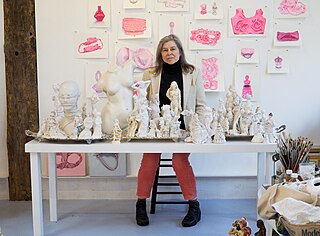Related Research Articles

Renee Cox is a Jamaican-American artist, photographer, lecturer, political activist and curator. Her work is considered part of the feminist art movement in the United States. Among the best known of her provocative works are Queen Nanny of the Maroons, Raje and Yo Mama's Last Supper, which exemplify her Black Feminist politics. In addition, her work has provoked conversations at the intersections of cultural work, activism, gender, and African Studies. As a specialist in film and digital portraiture, Cox uses light, form, digital technology, and her own signature style to capture the identities and beauty within her subjects and herself.
Laura Cottingham is an American art critic, curator and visual artist. Her most recent book is Angst essen Seele auf on Rainer Werner Fassbinder published by the British Film Institute in 2005. Her work has been exhibited in galleries and museums throughout Europe and in New York City, her best known videos being Not For Sale, 1998 and The Anita Pallenberg Story, 2000. She curated "NowHere," for the Louisiana Museum of Art, Denmark in 1996 and "Vraiment Feminisme et art," for Le Magasin in Grenoble, France in 1997. She lives in New York City.
Amelia Jones, originally from Durham, North Carolina, is an American art historian, art theorist, art critic, author, professor and curator. Her research specialisms include feminist art, body art, performance art, video art, identity politics, and New York Dada. Jones's earliest work established her as a feminist scholar and curator, including through a pioneering exhibition and publication concerning the art of Judy Chicago; later, she broadened her focus on other social activist topics including race, class and identity politics. Jones has contributed significantly to the study of art and performance as a teacher, researcher, and activist.
Faith Wilding is a Paraguayan American multidisciplinary artist - which includes but is not limited to: watercolor, performance art, writing, crocheting, knitting, weaving, and digital art. She is also an author, educator, and activist widely known for her contribution to the progressive development of feminist art. She also fights for ecofeminism, genetics, cyberfeminism, and reproductive rights. Wilding is Professor Emerita of performance art at the School of the Art Institute of Chicago.

Marcia Tucker was an American art historian, art critic and curator. In 1977 she founded the New Museum of Contemporary Art, a museum dedicated to innovative art and artistic practice in New York City, which she ran as the director until 1999.

A.I.R. Gallery is the first all female artists cooperative gallery in the United States. It was founded in 1972 with the objective of providing a professional and permanent exhibition space for women artists during a time in which the works shown at commercial galleries in New York City were almost exclusively by male artists. A.I.R. is a not-for-profit, self-underwritten arts organization, with a board of directors made up of its New York based artists. The gallery was originally located in SoHo at 97 Wooster Street, and was located on 111 Front Street in the DUMBO neighborhood of Brooklyn until 2015. In May 2015, A.I.R. Gallery moved to its current location at 155 Plymouth St, Brooklyn, NY 11201.
Lucy Rowland Lippard is an American writer, art critic, activist, and curator. Lippard was among the first writers to argue for the "dematerialization" at work in conceptual art and was an early champion of feminist art. She is the author of 26 books on contemporary art and has received numerous awards and accolades from literary critics and art associations. She lives in Galisteo, New Mexico.

The feminist art movement in the United States began in the early 1970s and sought to promote the study, creation, understanding and promotion of women's art. First-generation feminist artists include Judy Chicago, Miriam Schapiro, Suzanne Lacy, Judith Bernstein, Sheila de Bretteville, Mary Beth Edelson, Carolee Schneeman, Rachel Rosenthal, and many other women. They were part of the Feminist art movement in the United States in the early 1970s to develop feminist writing and art. The movement spread quickly through museum protests in both New York and Los Angeles, via an early network called W.E.B. that disseminated news of feminist art activities from 1971 to 1973 in a nationally circulated newsletter, and at conferences such as the West Coast Women's Artists Conference held at California Institute of the Arts and the Conference of Women in the Visual Arts, at the Corcoran School of Art in Washington, D.C..

Video Data Bank (VDB) is an international video art distribution organization and resource in the United States for videos by and about contemporary artists. Located in Chicago, Illinois, VDB was founded at the School of the Art Institute of Chicago in 1976 at the inception of the media arts movement.
Australian feminist art timeline lists exhibitions, artists, artworks and milestones that have contributed to discussion and development of feminist art in Australia. The timeline focuses on the impact of feminism on Australian contemporary art. It was initiated by Daine Singer for The View From Here: 19 Perspectives on Feminism, an exhibition and publishing project held at West Space as part of the 2010 Next Wave Festival.
Martha Wilson is an American feminist performance artist and the founding director of Franklin Furnace Archive art organization. Over the past four decades she has developed and "created innovative photographic and video works that explore her female subjectivity through role-playing, costume transformation, and 'invasions' of other peoples personas". She is a recipient of two National Endowment for the Arts fellowships, a New York Foundation for the Arts fellowship, and an Obie Award and a Bessie Award for commitment to artists’ freedom of expression. She is represented by P.P.O.W. Gallery in New York City.
Cornelia H. Butler is an American museum curator, author, and art historian. Since 2023, Butler is the Director of MoMA PS1. From 2013 to 2023, she was the Chief Curator at the Hammer Museum in Los Angeles.
The feminist art movement refers to the efforts and accomplishments of feminists internationally to produce art that reflects women's lives and experiences, as well as to change the foundation for the production and perception of contemporary art. It also seeks to bring more visibility to women within art history and art practice. The movement challenges the traditional hierarchy of arts over crafts, which views hard sculpture and painting as superior to the narrowly perceived 'women's work' of arts and crafts such as weaving, sewing, quilting and ceramics. Women artists have overturned the traditional view by, for example, using unconventional materials in soft sculptures, new techniques such as stuffing, hanging and draping, and for new purposes such as telling stories of their own life experiences. The objectives of the feminist art movement are thus to deconstruct the traditional hierarchies, represent women more fairly and to give more meaning to art. It helps construct a role for those who wish to challenge the mainstream narrative of the art world. Corresponding with general developments within feminism, and often including such self-organizing tactics as the consciousness-raising group, the movement began in the 1960s and flourished throughout the 1970s as an outgrowth of the so-called second wave of feminism. It has been called "the most influential international movement of any during the postwar period."
Feminist art criticism emerged in the 1970s from the wider feminist movement as the critical examination of both visual representations of women in art and art produced by women. It continues to be a major field of art criticism.
Katy Deepwell is a feminist art critic and academic, based in London. She is the founder and editor of n.paradoxa: international feminist art journal, published 1998-2017, in 40 volumes by KT press. She founded KT press as a feminist not-for-profit publishing company to publish the journal and books on feminist art. KT press has published 8 e-books, supported by the Andy Warhol Foundation for the Visual Arts. In Feb 2017, Katy Deepwell wrote and published a MOOC on feminism and contemporary art at. In May 2020, a second advanced course on feminist art manifestos was added to the site. The model for both MOOCs is FemTechNet’s DOCC: Distributed Open Collaborative Course.
Willie Young is a 20th-century American artist. Young is mainly self-taught, and his work has been exhibited alongside other prominent outsider artists, such as Bill Traylor, Nellie Mae Rowe and Thornton Dial. The main body of his work consists of delicately rendered graphite drawings.
Alter / Image: Feminism and Representation in New Zealand Art 1973-1993 was an exhibition curated by Tina Barton and Deborah Lawler-Dormer to mark the centennial of women's suffrage in New Zealand. It showed at City Gallery Wellington from 1 August to 21 November 1993 and Auckland City Art Gallery from 17 December 1993 to 20 February 1994.
This is a timeline of the feminist art movement in New Zealand. It lists important figures, collectives, publications, exhibitions and moments that have contributed to discussion and development of the movement. For the indigenous Māori population, the emergence of the feminist art movement broadly coincided with the emergence of Māori Renaissance.

Portia Munson is an American visual artist who works in sculpture, installation, painting, and digital photography, focusing on themes related to the environment and feminism. Her work includes large-scale agglomerations of mass-produced plastic found objects arranged by color, as well as small oil paintings of individual domestic found objects, and digital photographs of flowers, weeds, and dead animals found near her home in upstate New York.
Global Feminisms was a feminist art exhibition that originally premiered at the Elizabeth A. Sackler Center for Feminist Art at the Brooklyn Museum, New York City, United States, in March 2007. The exhibition was co-curated by Maura Reilly and Linda Nochlin and consists of work by 88 women artists from 62 countries. Global Feminisms showcased art across many mediums, all trying to answer the question "what is feminist art?". The show was visually anchored by the installation of Judy Chicago's The Dinner Party.
References
- 1 2 "The New Museum, Annual Report, 1992–1994". New Museum Digital Archive. New Museum. 1994. Retrieved 2018-04-11.
- ↑ "Pink Project, 1994". New Museum Digital Archive. Retrieved 2018-04-11.
- ↑ "Bad Girls (Part I)". New Museum Digital Archive.
- 1 2 3 Smith, Roberta. "Review/Art; A Raucous Caucus Of Feminists Being Bad" . Retrieved 2018-04-11.
- 1 2 3 Bad girls. New York: New Museum of Contemporary Art. 1994. ISBN 0262700530. OCLC 30897735.
- ↑ Pachmanová, Martina (2006). Mobile fidelities : conversations on feminism, history and visuality. London: KT Press. ISBN 0953654117. OCLC 75713053.
- 1 2 3 Nixon, Mignon: Bad Enough Mother, "October", Vol. 71, feminist issues (Winter, 1995), pp. 70–92. MIT Press
- 1 2 Satin, Leslie, "Girls Girls Girls", Women and Performance: A Journal of Feminist Theory Vol. 7, Issue 1 (1994)
- ↑ Jones, Amelia (2010). The feminism and visual culture reader (2nd ed.). London: Routledge. ISBN 978-0415543705. OCLC 435731525.
- ↑ "Daughter of Bad Girls". Art in America. 2014.
- ↑ Richmond, Susan (Jan 2005). "Sizing up the Dildo: 1974 Artforum Advertisement as a Feminist Icon". Paradoxa. Vol. 15. pp. 24–34.